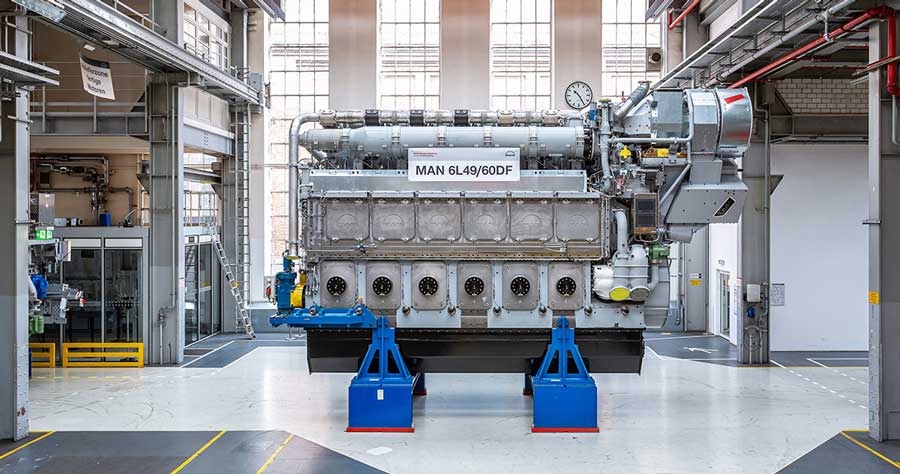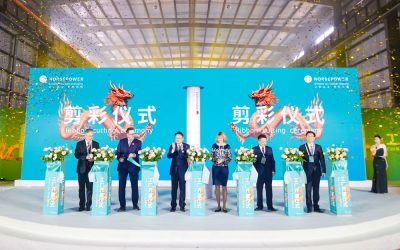Raising its game in the wide-bore, medium-speed engine stakes, MAN Energy Solutions has introduced its most powerful dual-fuel, four-stroke engine to date. Spanning the 7,800-18,200kW maximum output range, the 49/60DF design exceeds the larger 51/60DF in potency, while consuming less fuel, such that it is claimed to achieve a class-leading standard of efficiency in both gas and diesel modes.
The technological progression implicit in the latest addition to the Augsburg portfolio is testament to the intensity of competition in the market segment, notwithstanding the very few players involved. The 49/60 platform on which the dual-fuel engine is based embodies long-term thinking in bestowing a multi-fuel capability and adaptability, a concept which is also pivotal to the similarly powered 46TS-DF four-stroke developed by Wärtsilä.
The MAN 49/60DF has a maximum continuous rating of 1,300kW per cylinder at 600rpm, compared to the 1,150kW/cyl of the high-power variant of the 51/60DF running at 500/514rpm, and is superior in terms of fuel-burning performance. The output is, however, on a par with that of the 45/60CR diesel engine announced a few years ago, but above that of the 1,200kW/cyl at 500/514rpm of the 48/60CR design, which the 45/60CR was intended to eventually supersede.
In terms of fuel efficiency, the 49/60DF is described as setting a new benchmark. At 85% maximum continuous rating (MCR), fuel consumption is quantified as 6,990kJ/kWh in gas mode and 171g/kWh on liquid fuel, making for a significant differential in relation to its dual-fuel predecessor, the 51/60DF, which was developed from the 48/60 diesel engine.
For example, vee-type models of the 51/60DF in its ‘High Efficiency’ version are catalogued as offering 175.5g/kWh and 7,150kJ/kWh in diesel and gas modes, respectively, at 85% MCR, while the ‘High Power’ variant in vee configuration (slightly less fuel-hungry than the in-line models) burns 181.0g/kWh and 7,250-7,300kJ/kWh in respective diesel and gas operation, at the 85% output level.
Vessel versatility
The configuration versatility afforded by the 49/60DF across its in-line and vee-form layouts, and suitability for either diesel-mechanical or diesel-electric applications, makes for a broad market reach including cruise ships, ro-pax ferries, ro-ro vessels, LNG carriers and special-purpose types such as large dredgers.
The IMO Tier III standard is achieved in gas mode without secondary measures, while compliance in diesel mode can be met by adopting the proprietary, selective catalytic reduction (SCR) low-pressure system. Soot emissions when running on oil are halved, thanks to the effectiveness of the company’s latest common-rail fuel injection technology. Moreover, methane slip when gas-fired will be considerably reduced, by 40% or more, compared to the 51/60DF engine.
In companion with the efficiency underpinning the platform, the 49/60DF is distinguished by the extent of fuel flexibility and hence the various emission and decarbonisation paths it offers operators to maintain vessel emissions compliance through to 2050. It is capable of running on LNG, marine diesel oil (MDO) and heavy fuel oil (HFO) as well as a number of more sustainable fuels including biofuel blends and synthetic natural gas. In addition, retrofit solutions for methanol are in the planning stage at Augsburg.
While the MAN TCT/TCX two-stage turbocharging is pivotal to the power upgrade encapsulated by the 49/60DF, the new Adaptive Combustion Control 2.0 technology is a key enabler for the improved efficiency and operational performance, allowing automatic engine adaptation to changing ambient conditions, varying bunker quality, and engine wear. ACC 2.0 is pivotal to the way in which the 49/60DF pushes the bounds in dynamic engine running, allowing vessels to operate in gas mode in the most challenging situations such as manoeuvring.
Cybersecurity compliance
The proprietary Safety and Control System (SaCoS) encapsulated by the 49/60DF is the latest iteration (designated SaCoS 5000) of the proven SaCoS One system, focusing on reliability, robustness and comprehensive functionality. It embodies a performance upgrade in all components, and offers the added benefit of facilitating the new engine’s compliance with rigorous cybersecurity requirements.
SaCoS 5000 was initially brought to bear on the MAN 45/60CR diesel engine launched in 2017, and has been subsequently further refined for roll-out in other units of the four-stroke range. The system offers an improved interface for data transfer, facilitating remote analysis and support functions in technical management. While the primary focus to ensure the safety and availability of the engine and the ship, SaCoS 5000 has also been conceived with cybersecurity in mind.
The 45/60CR engine is equally as potent as the 49/60DF, turning out 1,300kW per cylinder at a crankshaft rotation of 600rpm. The 450mm-bore 45/60CR was unveiled with SFOC at just 166-167g/kWh. Significantly, in the next development of the 49/60 platform, the OEM plans to introduce a diesel version during 2023, and this will be retrofit-ready for running on LNG and methanol.
Dual-fuel engine
Meanwhile, type approval testing for the new dual-fuel engine is anticipated in March this year, and the company cited a 15-month order-to-delivery timeframe for the first production engine, which would realise an at-sea newbuild installation in 2025.
The validation programme had started in 2018 with a single-cylinder prototype, leading to over 1,000 operating hours with a six-cylinder model on the testbed from April 2021 onwards, including an extreme condition test conducted last year at 120% load.
The launch of the 49/60DF was followed by the signing of an agreement between ABB and MAN Energy Solutions to collaborate on the development of dual-fuel electric power systems for LNG carriers. The memorandum of understanding envisaged propulsion plant based on the new dual-fuel engine and ABB’s Dynamic AC (DAC) power distribution and control system.
The DAC concept combines the merits of conventional AC with variable frequency, whereby generator loads can be adjusted to engine speed, thereby optimising fuel consumption continuously and over the ship’s complete operating profile.







